R.J. Stowell's Blog: rjsomeone, page 13
December 29, 2020
Same Auld Lang Syne
I've shared my appreciation for quirky, melancholy Christmas songs, from Joni Mitchell's "River" to "Gabriel's Message" (Sting). This is one of my favorite story-songs as well, 1980's "Same Auld Lang Syne" by Dan Fogelberg. Carly Simon said it more accurately for me – "These are the good old days" – (COVID and all), but this true story is one we all feel looking back on our youth. The first line of melody, by the way, is Tchaikovsky’s 1812 Overture. Enjoy the video.
Met my old lover in the grocery store
The snow was falling Christmas Eve
I stole behind her in the frozen foods
And I touched her on the sleeve
She didn't recognize the face at first
But then her eyes flew open wide
She went to hug me and she spilled her purse
And we laughed until we cried
We took her groceries to the checkout stand
The food was totaled up and bagged
We stood there lost in our embarrassment
As the conversation dragged
Went to have ourselves a drink or two
But couldn't find an open bar
We bought a six-pack at the liquor store
And we drank it in her car
We drank a toast to innocence
We drank a toast to now
And tried to reach beyond the emptiness
But neither one knew how
She said she'd married her an architect
Who kept her warm and safe and dry
She would have liked to say she loved the man
But she didn't like to lie
I said the years had been a friend to her
And that her eyes were still as blue
But in those eyes I wasn't sure if I
Saw doubt or gratitude
She said she saw me in the record stores
And that I must be doing well
I said the audience was heavenly
But the traveling was hell
We drank a toast to innocence
We drank a toast to now
And tried to reach beyond the emptiness
But neither one knew how
We drank a toast to innocence
We drank a toast to time
Reliving in our eloquence
Another "Auld Lang Syne"
The beer was empty and our tongues were tired
And running out of things to say
She gave a kiss to me as I got out
And I watched her drive away
Just for a moment I was back at school
And felt that old familiar pain
And as I turned to make my way back home
The snow turned into rain
#milesfromnowhere
The Food Mart in the video is the place where the story actually took place, 1302 E. Frye Ave. and North Prospect Road in Peoria, Illinois.
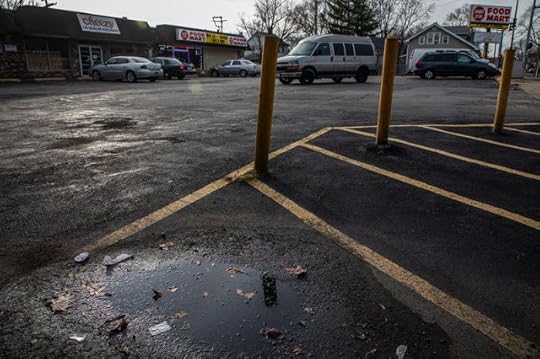
December 28, 2020
The Year in Review - 1970: July - December
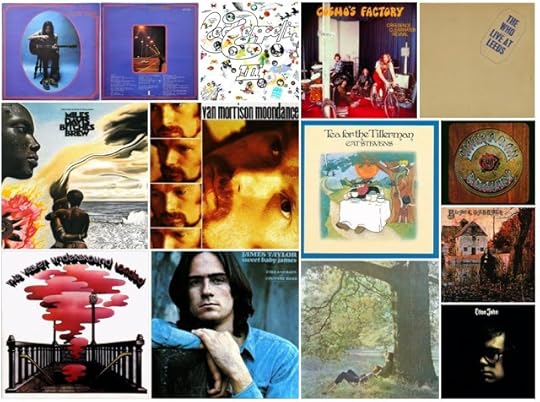
The last post highlighted those stellar LPs 1970 through June. 1970 was a year in which a new era of rock began with new bands like ELP, Gentle Giant and ELO, and while the progressive rock era had begun, 60s artists like Joni Mitchell would evolve to put out their finest work.
July 1970 gave us one of the biggest selling albums of the year, an LP that one could mistake for a greatest hits collection, CCR's Cosmo's Factory with hits like "Up Around the Bend" and "Looking Out My Back Door."
August would bring a myriad of diversity but on the last day of the month came an LP we’ve only recently rated as an AM10, Neil Young's incomparable After the Gold Rush. But what diversity indeed, also released this month was the Carpenter's Close to You and Frank Zappa and the Mothers' Weasels Ripped My Flesh.
September offers up diversity as well with Santana's Abraxas with their key hit, "Black Magic Woman," a cover of a Fleetwood Mac song from several years earlier. Curtis Mayfield hit the soul charts with one of the greatest productions of the era, Curtis. Black Sabbath, btw, would release their 2nd LP of the year, the stellar Paranoid.
In October I'm forced to break my promise of highlighting just one LP per month (I know, I've been doing that all along), but seriously, the debut from Emerson, Lake and Palmer, amazing, Pink Floyd's epic Atom Heart Mother, Led Zeppelin III, Elton John's Tumbleweed Connection, and Trespass from Genesis. Enough said; find a month that can top those five all released simultaneously. My allowance just wasn’t big enough.
I should only talk about All Things Must Pass for November, but again, come on. Bowie's The man Who Sold the World, another LP from Grateful Dead, American Beauty, Derek and the Dominos' Layla and Other Assorted Love Songs, Gentle Giant's debut, and Tea for the Tillerman…again, amazing.
December we can focus again. Lennon's Plastic Ono Band is one of the year's highlights and Lennon's finest offering after the Beatles. Not a commercial LP by any means, Plastic Ono is raw and poetic. Imagine is more user friendly, but this is the Lennon he couldn’t be as a part of the world's most iconic pop band.
And we're off to an unmatched decade. The years to follow would only get better, but 1970 had a number of AM10s and saw the formation of bands like Queen and ELP; the switch from Am radio to AOR (Album Oriented Rock) on FM had begun.
December 27, 2020
1970 – The Year in Review: January - June
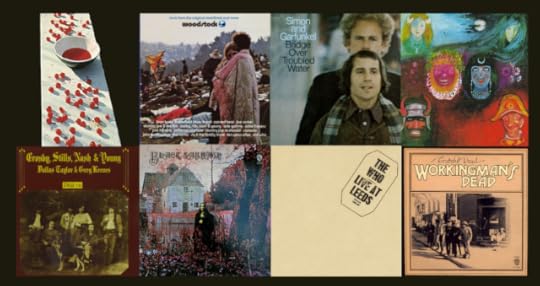
No one wants to review 2020. Indeed, we will all be glad when 2020 is hindsight. Not that there wasn’t worthy music with artists working from out of their homes or, like Pixar’s Soul, were made taking turns in the studio and through Zoom (stellar, classic Pixar, btw – and the best soundtrack since Edward Norton’s Motherless Brooklyn). But let's chronicle the LPs of 1970 instead (I couldn’t possibly begin to rank the year’s LPs from best to worst, nor could I cover them all). Just one per month or the list would be three days long.The first significant release of the year was Simon and Garfunkel's Bridge Over Troubled Water, their best-selling and final LP, released on January 26. Maybe not as significant as Bookends, the duo ended their career with three of their biggest hits, but more so, a youthful interpretation of the world in which we lived, the title track a veiled protest of Vietnam and civil rights violations.Arguably the first Heavy Metal album from the first Heavy Metal Band, February saw the release of the debut LP from Black Sabbath. I would say no to both, the LP is more psychedelic than Heavy Metal and was preceded by The Stooges and MC5 (among others), nonetheless, a new genre had arisen (from hell, obviously).March brought us an AM10 and one of the great Americana LPs, Déjà vu from Crosby, Stills, Nash and Young. Four incredible talents coming together to release a masterpiece, each song a classic rock staple. "Our House," "Helpless," "Woodstock," "Teach Your Children," "Carry On," and "Country Girl" were each genre/era-defining. Legendary! Here, though I have to break the post rule (for the first time, already) and give a definitive shout out to Ladies of the Canyon from Joni Mitchell. It wasn't Blue but it was getting there and darn close; a defining LP.April is more about recording than releases with Derek and the Dominos, Neil Young and the Grateful dead gearing up for later in the year, but two significant players released important debuts, Elton John and Paul McCartney, each with eponymous LPs. Were I to whittle down, Elton's American debut is the far superior LP but for, of course, McCartney’s "Maybe I’m Amazed."May gave us the last Beatles LP, Let It Be, which, despite its production by Phil Spectre, was a back-to-basics LP that would offer two No. 1 hits in the title track and "The Long and Winding Road." The Beatles always significant, I can't leave off one of the catalysts to progressive rock, King Crimson's In the Wake of Poseidon.June would bring on the first of two releases for the year from The Grateful Dead, Workingman's Dead, which alongside partner, American Beauty, make up the Dead's most significant studio work.
I broke my own rules with a pair of LPs in several of the months, but how hard it was to leave off LPs like Diana Ross's debut as a solo artist, Deep Purple in Rock, Bitches Brew from Miles Davis (the first Fusion LP), The Doors' Morrison Hotel, Van Morrison's Moondance, and Sweet Baby James. Keep in mind, the year ahead only gets better. Final note, just a shortlist of bands that formed in 1970: Aerosmith, Doobie Brothers, America, Emerson, Lake and Palmer, ELO, Gentle Giant, Queen and Weather Report. Here’s to better things to come, then and now.#milesfromnowhere
December 23, 2020
The Origins of Progressive Rock - Step One - Gentle Giant
 Phil, Derek and Ray Shulman formed pop-soul act Simon Dupree And The Big Sound in 1966. They released several non-charting singles for EMI, then on the advice of their management, embraced psychedelia and scored a UK Top 10 hit with "Kites" in 1967. The brothers hated the song and, fed up with the pop music machine, they quit the group in 1969. They formed Gentle Giant the following year, enlisting former Big Sound member Martin Smith on drums, alongside virtuoso guitarist Gary Green and classically trained pianist Kerry Minnear. The multi-instrumentalists were snapped up by Philips/Phonogram offshoot Vertigo with David Bowie producer Tony Visconti producing.
Phil, Derek and Ray Shulman formed pop-soul act Simon Dupree And The Big Sound in 1966. They released several non-charting singles for EMI, then on the advice of their management, embraced psychedelia and scored a UK Top 10 hit with "Kites" in 1967. The brothers hated the song and, fed up with the pop music machine, they quit the group in 1969. They formed Gentle Giant the following year, enlisting former Big Sound member Martin Smith on drums, alongside virtuoso guitarist Gary Green and classically trained pianist Kerry Minnear. The multi-instrumentalists were snapped up by Philips/Phonogram offshoot Vertigo with David Bowie producer Tony Visconti producing. What emerged from the sessions at Trident Studios was a radical departure from their previous work, as the eponymous Gentle Giant debut album, released on November 27, 1970, saw the group immersed in the nascent prog-rock sound, expanding the genre’s horizons with a variety of different styles and influences. Hard rocking opener "Giant" signaled their seriousness as musicians, with a host of complex tempo changes, while the gentle “Funny Ways” utilized folk, medieval and classical music tropes – all styles to which the band would return to repeatedly over their subsequent career. "Alucard" ("Dracula" spelled backward) found Kerry Minnear taking center stage, with his riotously inventive synth- and organ-playing punctuated with blasts of horn and Gary Green’s bluesy guitar. Best of all, though, was the epic "Nothing At All," whose stunning mix of multiple vocal harmonies and epic guitar riffs manages to recall both Crosby, Stills, Nash and Young, and Led Zeppelin’s "Stairway To Heaven."
Gentle Giant is one of the most innovative debuts in rock history, and it also remains a captivating listen fifty years later. Often dismissed in comparison to what was next, it is not something to be overlooked by any fan of eclectic progressive rock, particularly in that, for this writer, Gentle Giant is indeed the very first truly recognizable prog LPs. (That of course will cause comments galore.) Most will point to Zappa or King Crimson, but those elements that truly say prog are missing with so many of the precursors - odd time signatures, multi-instrumentalism, keyboard arpeggios, conceptual ideology. Zappa was more Psychedelic and Crimson Art Rock. Indeed the catalyst for this album was established with a myriad of LPs, from the Moodies' essential canon (three LPs precede GG) to The Nice to, of course, In the Court of the Crimson King (the prog standard-bearer), but Gentle Giant is still, if arguably when it all meshed.
The Origins of Prog - Sort Of...
 The mention of the term will result in blank stares that generally lead to the question, "What is progressive music?" We can generalize: Longer songs (or epics); time changes and odd time signatures; complex, sophisticated instrumentation and composition; conceptual ideas and heightened, lyrical content; classical and jazz influences. These general guidelines hold true now, as they did during prog's heyday in the mid-70s. Tracing prog's history is a bit more speculative. What may be confusing is mistaking what is avant-garde for progressive. While prog can be extremely experimental (think "We Have Heaven" from Yes or Gentle Giant's "Knots"), the utterly experimental and avant-garde Trout Mask Replica cannot be mistaken as progressive.
The mention of the term will result in blank stares that generally lead to the question, "What is progressive music?" We can generalize: Longer songs (or epics); time changes and odd time signatures; complex, sophisticated instrumentation and composition; conceptual ideas and heightened, lyrical content; classical and jazz influences. These general guidelines hold true now, as they did during prog's heyday in the mid-70s. Tracing prog's history is a bit more speculative. What may be confusing is mistaking what is avant-garde for progressive. While prog can be extremely experimental (think "We Have Heaven" from Yes or Gentle Giant's "Knots"), the utterly experimental and avant-garde Trout Mask Replica cannot be mistaken as progressive.Picking a starting point is a bit like putting a pin in a globe to choose one's vacation. This writer sticks a pin in The Mothers of Invention's Freak Out from 1966, in particular, "Help, I'm a Rock." Zappa's sophomore release, Absolutely Free, may more specifically be progressive, but I'll stick with Freak Out as where it all began, but only in the same way that Robert Johnson in the 1930s created rock 'n' roll. Definitive prog instead would come in 1970 with two LPs that truly fit the mold, Gentle Giant and Emerson, Lake and Palmer, the eponymous debuts from both bands. More on that in the next post.
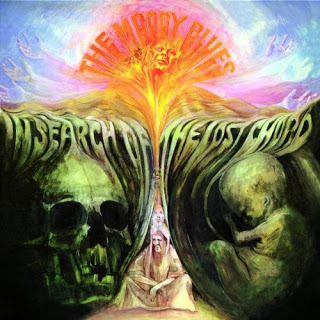 What appears today as run of the mill (hardly) was ground-breaking in 1967. The idea of fusing psychedelic rock with orchestral arrangements was an improbable marriage. The Moody Blues somehow made it work on the prog classic Days of Future Passed. A true concept album, Days of Future Passed is thematic in that it follows a day's activity. As "The Day Begins" Graeme Edge commands the sun to rise. The optimism of the early morning is reflected in Michael Pinder's "Dawn is a Feeling" and in Ray Thomas' "Another Morning". By the afternoon, the recording takes on a surreal quality typical of later psychedelic recordings; indeed, John Lodge's compositions ("Peak Hour", "Forever Afternoon") are truly inspired. Despite the "typical day," the symphonic arrangements with the London Festival Orchestra are far from ordinary. In essence, Days was a fluke, a mistake, but for scores of flower children, the LP was their first exposure to classical orchestration and soaring melodies. In actuality, the album is more proto-prog than prog: for all of its orchestral ambitions, the songs stick largely to pop song formats. And yet, the way the group tried to seriously meld themselves with the orchestra, rather than simply use it as a sweetening device as in earlier pop music, was important--it's the *intent* here that counts. Not to mention, the group's unabashedly "cosmic" aspirations which would be a more defining characteristic of prog than Zappa's more biting, punkish social satire.
What appears today as run of the mill (hardly) was ground-breaking in 1967. The idea of fusing psychedelic rock with orchestral arrangements was an improbable marriage. The Moody Blues somehow made it work on the prog classic Days of Future Passed. A true concept album, Days of Future Passed is thematic in that it follows a day's activity. As "The Day Begins" Graeme Edge commands the sun to rise. The optimism of the early morning is reflected in Michael Pinder's "Dawn is a Feeling" and in Ray Thomas' "Another Morning". By the afternoon, the recording takes on a surreal quality typical of later psychedelic recordings; indeed, John Lodge's compositions ("Peak Hour", "Forever Afternoon") are truly inspired. Despite the "typical day," the symphonic arrangements with the London Festival Orchestra are far from ordinary. In essence, Days was a fluke, a mistake, but for scores of flower children, the LP was their first exposure to classical orchestration and soaring melodies. In actuality, the album is more proto-prog than prog: for all of its orchestral ambitions, the songs stick largely to pop song formats. And yet, the way the group tried to seriously meld themselves with the orchestra, rather than simply use it as a sweetening device as in earlier pop music, was important--it's the *intent* here that counts. Not to mention, the group's unabashedly "cosmic" aspirations which would be a more defining characteristic of prog than Zappa's more biting, punkish social satire. While The Moodies were busy attempting to meld rock and orchestral sounds, Keith Emerson, and The Move were busy incorporating classical and jazz elements within a tighter four-piece (later three-piece) rock band arrangement, using only his considerable virtuosity at the keyboard and a partnership with Robert Moog. The results would do more to influence prog-rock, and keyboards in general, than any other album for years to come. While "Emerlist Davjack" is more of a transitional album between psychedelia and prog, the LP is as progressive as much of ELP's later work.
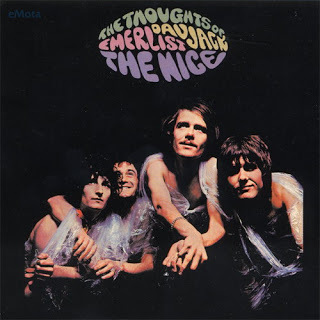 Also in 1967, the Moodies were back with In Search of the Lost Chord. Here we may find the very first intrinsically progressive LP. A mini-suite opens with "House Of Four Doors," a solemn and somewhat mystical number that features the sound of different doors opening into different musical worlds: medieval guitar and flute, a baroque harpsichord, and a 19th-century orchestra, leading to the fourth and final door which opens cleverly into the next song, "Legend Of A Mind." This psychedelic classic is a tribute to acid guru Tim Leary, which features a trippy mellotron hook played with a pitch bend. This upbeat track features a catchy melody and a series of exciting time changes, constantly building in strength until the piece quiets down for a mystical flute solo and more of the pitch-bended mellotron for maximum psych thrills. The break continues this mellotron/flute duet for a while, stretching the song way past pop boundaries and into solid prog territory, the track's orchestral grandeur becoming apparent as the band rejoins and gradually plays in a faster and faster tempo, soaring high until the chorus triumphantly returns. "House Of Four Doors" returns for a brief reprise, sounding moody and contemplative, a tambourine being stricken ritually as the group sings of different paths on the quest to enlightenment. And that's just side one.
Also in 1967, the Moodies were back with In Search of the Lost Chord. Here we may find the very first intrinsically progressive LP. A mini-suite opens with "House Of Four Doors," a solemn and somewhat mystical number that features the sound of different doors opening into different musical worlds: medieval guitar and flute, a baroque harpsichord, and a 19th-century orchestra, leading to the fourth and final door which opens cleverly into the next song, "Legend Of A Mind." This psychedelic classic is a tribute to acid guru Tim Leary, which features a trippy mellotron hook played with a pitch bend. This upbeat track features a catchy melody and a series of exciting time changes, constantly building in strength until the piece quiets down for a mystical flute solo and more of the pitch-bended mellotron for maximum psych thrills. The break continues this mellotron/flute duet for a while, stretching the song way past pop boundaries and into solid prog territory, the track's orchestral grandeur becoming apparent as the band rejoins and gradually plays in a faster and faster tempo, soaring high until the chorus triumphantly returns. "House Of Four Doors" returns for a brief reprise, sounding moody and contemplative, a tambourine being stricken ritually as the group sings of different paths on the quest to enlightenment. And that's just side one.By 1968 the genre would further emerge with bands like Tomorrow, Mabel Greer's Toyshop, Yes and King Crimson, not to mention the Canterbury Scene which was progressive all the way back to 1964. Progressive Rock would explode into the mainstream in the mid-70s with Tull, ELP and Genesis, finally self-aggrandizing itself so fully that it fell by the wayside amidst the clash of punk and disco. It would reemerge in the 90s with bands like Porcupine Tree. Interesting that Steven Wilson would look back so fondly on LPs like Gentle Giant's The Power and the Glory, remaster and mix them and offer them up to a new generation.
December 20, 2020
Calif. - Buy This Book!
As always, available on Amazon or for your Kindle. Get a signed copy by sending an email to rjsomeone@gmail.com!
December 19, 2020
am@random - AM 10s - Neil Young's After the Gold Rush
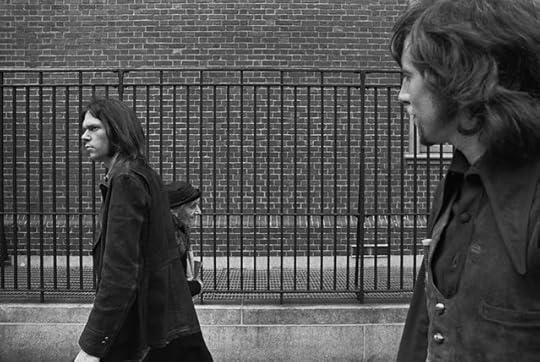 I was in my teens and caught a ride to the record shop to buy Harvest, the new release by Neil Young. In the parking lot, Pamela D. and I sat waiting as "Heart of Gold" played on the radio. The record shop was out of it, and I bought After the Gold Rush, instead. Harvest, of course is classic, mainstream America's introduction to Neil Young, but good fortune and brisk sales had me plop down $3.77 for Gold Rush. It was the best $3.77 I ever spent. By the release of the LP in 1970, Young had already shined in the rosters of two legendary bands (Buffalo Springfield and Crosby, Stills, Nash and Young), embarked on a premature 1969 self-entitled solo debut and collaborated with the garage rock band, Crazy Horse on Everybody Knows This Is Nowhere. Ripe for a flourishing solo career, the finely crafted After the Gold Rush defined the musical persona that would make Young a legend. Young's primary role was always that of a sweet, sentimental folky, and on After the Gold Rush, Young dishes out downbeat reflection ("Tell Me Why," "Don't Let It Bring You Down"), rainy, country rock ("Oh, Lonesome Me," "Cripple Creek Ferry") and gorgeous odes of encouragement ("I Believe In You," "Birds"), all encased in golden acoustic guitar and painted in Young's masterful use of imagery ("Old man lying by the side of the road/ With the lorries rolling by/ Blue moon sinking from the weight of the load/ And the buildings scrape the sky/ Cold wind ripping down the allay at dawn/ And the morning paper flies/ Dead man lying by the side of the road/ With the daylight in his eyes"). But After the Gold Rush revealed another quintessential truth about Young's psyche: this gentle singer/songwriter had a streak of embittered social conscious (the title track, the dead-on "Southern Man") and a flair for lumbering guitar rock ("When You Dance You Can Really Love," "Southern Man"). After the Gold Rush is the sound of inspiration arriving, doors cracking open and an artist being baptized.And it was all dumb luck. In January 1969, 23-year-old Neil Young released his self-titled solo debut album, its layers of guitars reminiscent of his work with the Buffalo Springfield. But when Young failed to crack the album charts, he immediately went back to work, recording Everybody Knows This Is Nowhere at Wally Heider's in less than two weeks with new backing band Crazy Horse.His association with Crosby, Stills and Nash left Young poised for stardom as he made plans to cut a third solo album in early 1970. Anyone else would've played it safe, but Young followed his instincts. "At that point, I didn’t like seeing other musicians in the hallways," Young told writer Jimmy McDonough. "I didn't like hearing other music. I just wanted to be by myself."Young set up shop in the basement of his Topanga Canyon home. He paneled the walls with pine milled from the trees in his backyard. Neil's modest gear collection included a Scully 8-track, a small mixer, and a handful of mics. Because there was no room for echo plates or other processors, the sound would be unusually arid with all the vocals cut live and dry. "There was a shitload of room on those recordings," recalled Young, " because there wasn’t anything else goin' on. Just rhythm guitar, bass and drums - that's all there was. The song was it, and everything else was supporting it."Young got even more minimalism out of Jack Nitzsche, who'd worked with Young during his days with the Buffalo Springfield. Nitzsche and Crazy Horse convened in the basement and cut "When You Dance I Can Really Love" totally live, with Young flailing away on his Gretsch White Falcon.It's this raw emotion and the straightforward approach that sets apart After the Gold Rush, which was released in late summer to unanimous acclaim; by Christmas, it had become Young’s first Top 10 album, and remained on the charts for over a year on its way to selling two million copies. Though a stunning success, Young's decision to bring it all back home would take its toll on his personal life. "I was writing ‘Southern Man’ in the studio," and [wife] Susan was angry at me for some reason, throwing things; they were crashing against the door." The same month the album was released, Young's already fractured first marriage officially came to a close; you can hear it in the vocals and in each riff. Like Joni on Ladies, or like Leonard Cohen, Neil Young had become the consummate singer-songwriter.
I was in my teens and caught a ride to the record shop to buy Harvest, the new release by Neil Young. In the parking lot, Pamela D. and I sat waiting as "Heart of Gold" played on the radio. The record shop was out of it, and I bought After the Gold Rush, instead. Harvest, of course is classic, mainstream America's introduction to Neil Young, but good fortune and brisk sales had me plop down $3.77 for Gold Rush. It was the best $3.77 I ever spent. By the release of the LP in 1970, Young had already shined in the rosters of two legendary bands (Buffalo Springfield and Crosby, Stills, Nash and Young), embarked on a premature 1969 self-entitled solo debut and collaborated with the garage rock band, Crazy Horse on Everybody Knows This Is Nowhere. Ripe for a flourishing solo career, the finely crafted After the Gold Rush defined the musical persona that would make Young a legend. Young's primary role was always that of a sweet, sentimental folky, and on After the Gold Rush, Young dishes out downbeat reflection ("Tell Me Why," "Don't Let It Bring You Down"), rainy, country rock ("Oh, Lonesome Me," "Cripple Creek Ferry") and gorgeous odes of encouragement ("I Believe In You," "Birds"), all encased in golden acoustic guitar and painted in Young's masterful use of imagery ("Old man lying by the side of the road/ With the lorries rolling by/ Blue moon sinking from the weight of the load/ And the buildings scrape the sky/ Cold wind ripping down the allay at dawn/ And the morning paper flies/ Dead man lying by the side of the road/ With the daylight in his eyes"). But After the Gold Rush revealed another quintessential truth about Young's psyche: this gentle singer/songwriter had a streak of embittered social conscious (the title track, the dead-on "Southern Man") and a flair for lumbering guitar rock ("When You Dance You Can Really Love," "Southern Man"). After the Gold Rush is the sound of inspiration arriving, doors cracking open and an artist being baptized.And it was all dumb luck. In January 1969, 23-year-old Neil Young released his self-titled solo debut album, its layers of guitars reminiscent of his work with the Buffalo Springfield. But when Young failed to crack the album charts, he immediately went back to work, recording Everybody Knows This Is Nowhere at Wally Heider's in less than two weeks with new backing band Crazy Horse.His association with Crosby, Stills and Nash left Young poised for stardom as he made plans to cut a third solo album in early 1970. Anyone else would've played it safe, but Young followed his instincts. "At that point, I didn’t like seeing other musicians in the hallways," Young told writer Jimmy McDonough. "I didn't like hearing other music. I just wanted to be by myself."Young set up shop in the basement of his Topanga Canyon home. He paneled the walls with pine milled from the trees in his backyard. Neil's modest gear collection included a Scully 8-track, a small mixer, and a handful of mics. Because there was no room for echo plates or other processors, the sound would be unusually arid with all the vocals cut live and dry. "There was a shitload of room on those recordings," recalled Young, " because there wasn’t anything else goin' on. Just rhythm guitar, bass and drums - that's all there was. The song was it, and everything else was supporting it."Young got even more minimalism out of Jack Nitzsche, who'd worked with Young during his days with the Buffalo Springfield. Nitzsche and Crazy Horse convened in the basement and cut "When You Dance I Can Really Love" totally live, with Young flailing away on his Gretsch White Falcon.It's this raw emotion and the straightforward approach that sets apart After the Gold Rush, which was released in late summer to unanimous acclaim; by Christmas, it had become Young’s first Top 10 album, and remained on the charts for over a year on its way to selling two million copies. Though a stunning success, Young's decision to bring it all back home would take its toll on his personal life. "I was writing ‘Southern Man’ in the studio," and [wife] Susan was angry at me for some reason, throwing things; they were crashing against the door." The same month the album was released, Young's already fractured first marriage officially came to a close; you can hear it in the vocals and in each riff. Like Joni on Ladies, or like Leonard Cohen, Neil Young had become the consummate singer-songwriter.Long time readers of the column will note the move up from an AM9 to an AM10. The LP was certainly perfect for its time, and now, in a time of musical mediocrity, the LP remains at the forefront of an Americana renaissance.
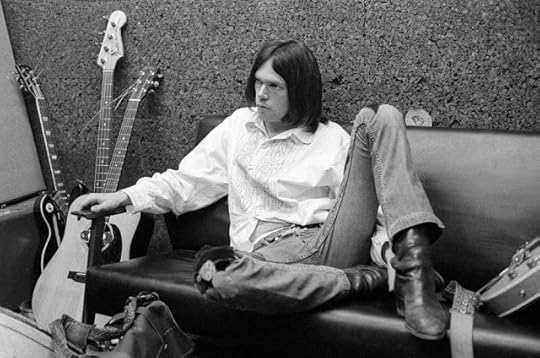
December 16, 2020
Christmas Happening - Laguna Beach, California - Forgotten Festivals
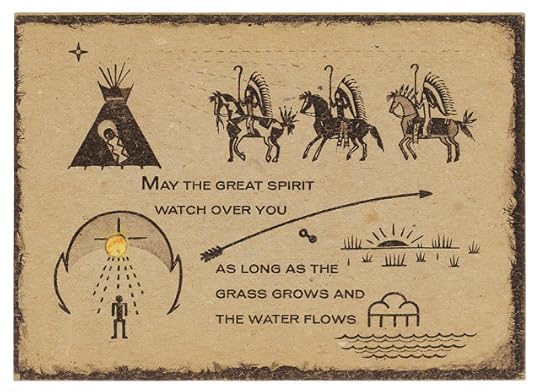 The Acid Postcard I found on eBay Last Week - Hands Off, It's Mine!
The Acid Postcard I found on eBay Last Week - Hands Off, It's Mine!The event was described by local police as "heavy on drugs, nudity, fornication and general orgiastic chaos." Contraband was "strewn across the Southern California landscape; booze and acid ran through the gutters for dogs to drink," or so the story goes (AM tends to romanticize hippie culture, while the media despised it). The event was billed as a one-day event of peace, love and music, but after three days it had turned into much more; an estimated 25,000 people gathered in a field of sycamore and eucalyptus trees for what is known today as the Christmas Happening.
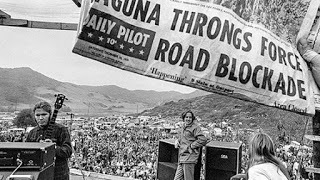 Despite massive traffic jams, freezing night temps and insufficient food, throngs of young people, Vietnam veterans and free spirits descended into the canyon near the intersection of Laguna Canyon and El Toro roads, evoking the scene a couple thousand miles away the year before. For participant Sunny Taylor-Colby, it was the best Christmas of her life. As she wandered amid the happening's So Cal vibe she felt something of an Aquarian spirit in the air: "I was 18 then and I had a wonderful time at that event with my boyfriend Bobby Lee Gregory. "I rode in on a bicycle's handlebars and it was just great. Everybody there was calm and awesome and beautiful and kind and sweet. Seriously, we were all mellow and chill." That is a memory worth its weight (anything in which one arrives on the handlebars of a bicycle is "mellow and chill; can we agree?).
Despite massive traffic jams, freezing night temps and insufficient food, throngs of young people, Vietnam veterans and free spirits descended into the canyon near the intersection of Laguna Canyon and El Toro roads, evoking the scene a couple thousand miles away the year before. For participant Sunny Taylor-Colby, it was the best Christmas of her life. As she wandered amid the happening's So Cal vibe she felt something of an Aquarian spirit in the air: "I was 18 then and I had a wonderful time at that event with my boyfriend Bobby Lee Gregory. "I rode in on a bicycle's handlebars and it was just great. Everybody there was calm and awesome and beautiful and kind and sweet. Seriously, we were all mellow and chill." That is a memory worth its weight (anything in which one arrives on the handlebars of a bicycle is "mellow and chill; can we agree?).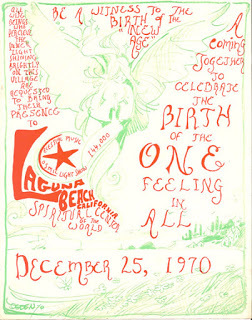 With the help of the Brotherhood of Eternal Love, an organization that dubbed itself "the Johnny Appleseeds of hallucinogenics," Orange Sunshine spread throughout the world. The Brotherhood's most dramatic display was there in Laguna that day; the nearly pure LSD25 derivative effectively riding in on a bike's handlebars - even better, littered across the sky, airmail, so to speak.
With the help of the Brotherhood of Eternal Love, an organization that dubbed itself "the Johnny Appleseeds of hallucinogenics," Orange Sunshine spread throughout the world. The Brotherhood's most dramatic display was there in Laguna that day; the nearly pure LSD25 derivative effectively riding in on a bike's handlebars - even better, littered across the sky, airmail, so to speak. Orange Sunshine had become ubiquitous thanks primarily to psychedelic evangelist Tim Scully, who spent hours in the lab creating the drug at the heart of the 1960s counter-culture movement. In the 1960s and 70s, the Brotherhood of Eternal Love made good on its quest to spread LSD to the public. By the time its leading members were arrested in 1972, the psychedelic religion had single-handedly distributed millions of tablets of acid throughout Southern California. A hippie named John Griggs, aka "Farmer John," was the founding father of the movement which aimed to spread the gospel of LSD and psychedelics. That gospel was registered as a legally recognized, tax exempt, religious organization in October of 1966, soon after acid was made illegal in California.
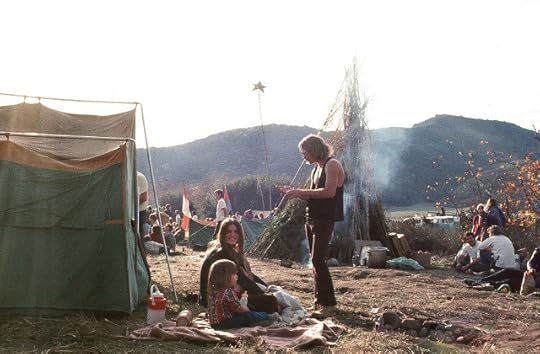
At first, Griggs' following was a small set happy to trip on the weekends and discuss future plans of running a commune together. When John learned of Timothy Leary's plans for the League of Spiritual Discovery, he decided to grow the Brotherhood into something similar. The new psychedelic religion's beliefs would center on spiritual freedom and the spread of LSD. The Brothers bought four white houses near the arts store in Laguna Beach and set about distributing pot and acid. They were soon moving hundreds of kilos of marijuana and acid to the bums, surfers, and hippies in the area. By 1967, the organization was transporting drugs cross country to New York and earning a huge payday while doing it.
As the Brotherhood's business ventures grew, Tim Scully, a sound equipment engineer for the Grateful Dead and an apprentice to LSD chemist Owsley Stanley, was forming his own ideas about acid. Like the Brotherhood, Scully believed that people became more gentle and more caring after tripping and had an idea that he could make the world a better place by distributing LSD to the masses.Together with chemist Nick Sand, Scully manufactured the Brotherhood's most recognizable brand of acid in a clandestine laboratory in California. In a little farmhouse in rural Sonoma County, the pair would make more than 3.6 million tablets of "Orange Sunshine," using a substance called ALD-52. The underground cooks soon joined forces with the Brotherhood to distribute the drug.
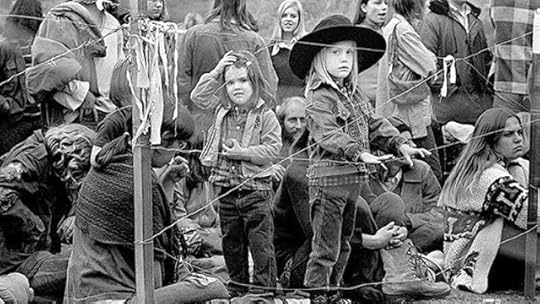 Distribution Members of the Brotherhood dispersed their trippy goods throughout California at Grateful Dead concerts, communes, love-ins, and the Altamont and Laguna festivals. The little orange tablets were so intertwined with the music scene of the era that Jimi Hendrix appeared in a Brotherhood film and performed a private show for its members.
Distribution Members of the Brotherhood dispersed their trippy goods throughout California at Grateful Dead concerts, communes, love-ins, and the Altamont and Laguna festivals. The little orange tablets were so intertwined with the music scene of the era that Jimi Hendrix appeared in a Brotherhood film and performed a private show for its members.  On Christmas Day, the "Laguna Greeter" (Eiler Larsen) welcomed the crowd to "Celebrate the birth of Jesus Christ." Local rock bands played and jammed, religious rituals and chants were performed, drugs were everywhere, homemade crafts were sold, and a baby or two was born. A typical rock gathering. Due to the make-shift arrangements, food and water supplies ran low, although the Hare Krishnas provided macrobiotic meals as best they could, and other locals brought turkey and hams in the spirit of the season.
On Christmas Day, the "Laguna Greeter" (Eiler Larsen) welcomed the crowd to "Celebrate the birth of Jesus Christ." Local rock bands played and jammed, religious rituals and chants were performed, drugs were everywhere, homemade crafts were sold, and a baby or two was born. A typical rock gathering. Due to the make-shift arrangements, food and water supplies ran low, although the Hare Krishnas provided macrobiotic meals as best they could, and other locals brought turkey and hams in the spirit of the season.Pressured by the larger than expected freak invasion, police sealed off the roads to and from the entire Laguna Beach district and allowed only emergency traffic and local residents through. Various solutions including off-road adventures up and down the hills with supplies of rice and water were devised by the festival crew. A medical tent had been erected, equipped with two volunteer doctors, some stretchers, and little else. The LA Times reported that "A spokesman for the Laguna Beach Free Clinic said several hundred persons were treated for everything from snake bites to a broken leg and drug overdoses."
There was no Altamont-like violence, although the usual amount of freakouts and bad trips occurred. An amusing snapshot was offered when the MC announced from the stage: "We got to have some Thorazine at the medical tent immediately, some guy drank a whole bottle of acid. I need some Thorazine up here too."
Altamont in many ways signaled the end of the utopian air provided large scale outdoor concerts, but the Christmas Happening proved that the hippie era may have evolved with the advent of the 70s, but it had only just begun.
December 15, 2020
I'm on this sci-fi kick... Five Years
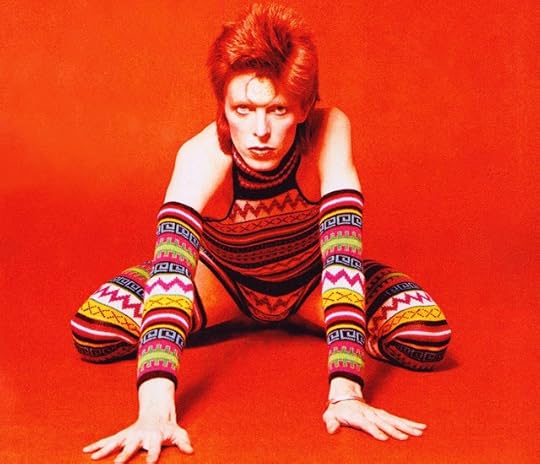
For this writer, Ziggy Stardust was the reason I do this today and why, for me, music is more than incidental. And while there is music that I appreciate more, even Bowie that I appreciate more (Hunky Dory, Diamond Dogs), Ziggy is the catalyst of my rapture. It's difficult to pinpoint why my choice wasn't Sgt. Pepper or The Monkees' Headquarters (or for that matter Bobby Vinton's Greatest Hits when I was five years old); these were the essential albums of my youth. I will venture to say that it was with Ziggy that I became introspective about music; that I began to analyze songs like this:
Of all Bowie’s dystopic and apocalyptic songs, "Five Years" is the most explicitly unsettling. One of the positive criticisms I get in my fiction (Yeah, yeah, Jay and the Americans) is that it's more about what is left unsaid; that it's all about the in-betweens. And so, we don't know why five years is all we've got, only that the planet has received a terminal prognosis and has to get its affairs in order. Ziggy's limited warning keeps his perspective on the street, on the masses who, having got the news, unravel. And yet there's an odd relief in the refrain of the track as if the misery-laden struggles of the mankind are finally over, indeed there is near celebration.
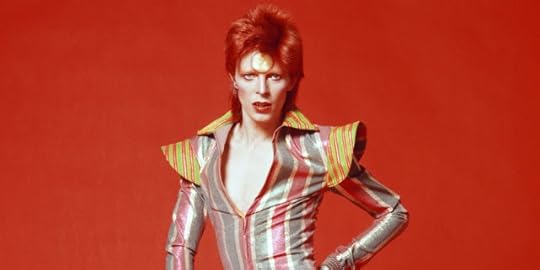
That Jubilation echoes "Memories of a Free Festival" from Space Oddity. While that song is a reflection of a Bowie performance at the Beckenham Arts Lab Free Festival on the day that his father died, there is a dystopian angst associated with it that alter the lyrics in a Five Years kind of way: "The sun machine is coming down and we’re gonna have a party."
In "Five Years," Bowie tapped into a current of pessimism and resignation that would define 1970s Britain in novels, films, music and real life. The Flower Power optimism in the 60stransmogrified into a 70s funk of hippie disillusionment amidst population bomb ecological nihilism - oh, oh, mercy, mercy me...
Bowie's tome mimicked a dystopian poem from 1967, Roger McGough's "At Lunchtime - A Love Story:
The buspeople, and there were many of them,
were shockedandsurprised and amused and annoyed, but when the
word got around that the world was coming to an end at
lunchtime, they put their pride in their pockets with their bustickets and
madelove one with the other.
The poem is set on a bus whose riders, learning the world will end at lunchtime, start having random sex. Watch it, a facsimile anyway, or read it here.
In "Five Years" the world has similarly turned upside-down. A "newsguy," forever emotionless and divorced from the everyday calamities of the world, openly weeps as he announces the impending catastrophe. Upon hearing the news, a policeman kneels to kiss the feet of a priest; we only had, after all, "five years left to cry in."
The inspiration underlying this philosophy had come from a dream Bowie had had in which he witnessed the reversal of the earth's electromagnetic field somewhere around the year 1977. For this reason, David refused to fly anywhere.
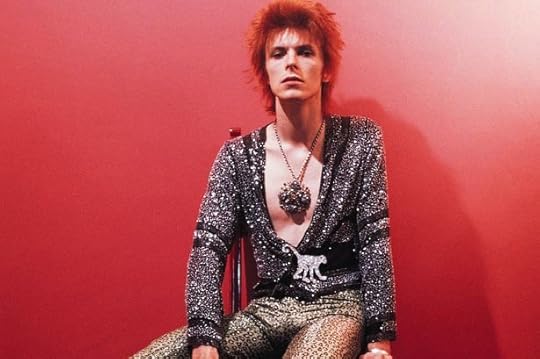
Assorted reactions to the impending disaster are observed and related humble narrator. Ziggy relates the plight of those around him: the fat-skinny, fall-short, nobody-somebody black soldier queer people. And yet, like in McGough's poem, the end, being nigh, brings a feeling of great optimism of what could and should be done. Bowie’s narrator makes his way through the desolate streets chronicling whatever he sees and only despairs when he remembers a friend (a former lover?) in an ice-cream shop, a moment of insignificance made unbearably poignant.
Consider the historical context of a world facing the real possibility of a nuclear apocalypse, and the tale of Ziggy Stardust and the Spiders from Mars begins to sound far less absurd. A suspenseful yet celebratory tone permeates the song, as though he and his band, the Spiders, had resigned themselves to their fate. The implication is that we should too. It's coming, they seem to proclaim, so why not enjoy it?
December 14, 2020
You Better Hang On To Yourself
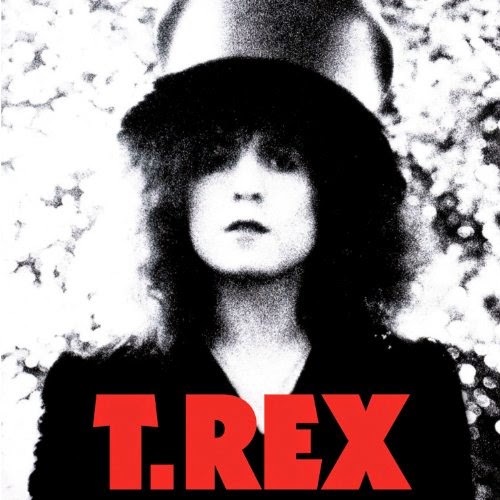 Glam rock, or glitter rock, emerged in the early 70s, a post-hippie phenomenon and antidote to all the earnest seriousness of the era. The dream was over, the stars burnt out and from the smoke of Altamont, came what? A teenaged transvestite revolution? Science fiction kabuki escapism? Exactly what the doctor ordered! There was still a sense of realism, a Hemingway sensibility in the U.S., but in England it was time to grasp the new decade with reckless abandon.
Glam rock, or glitter rock, emerged in the early 70s, a post-hippie phenomenon and antidote to all the earnest seriousness of the era. The dream was over, the stars burnt out and from the smoke of Altamont, came what? A teenaged transvestite revolution? Science fiction kabuki escapism? Exactly what the doctor ordered! There was still a sense of realism, a Hemingway sensibility in the U.S., but in England it was time to grasp the new decade with reckless abandon.The first artists to bridge the gap from hippies to glitter kids were the inimitable David Bowie and one time male model, Marc Bolan. Bolan, who for all intents and purposes was T. Rex, more or less invented glam rock in 1971 as the first to wear feather boas and top hats and to write songs not meant to be taken seriously. Dialing back the "freak-folk" of his first band, John's Children, and the original incarnation called Tyrannosaurus Rex, while adding an electrified Chuck Berry groove to his Tolkien tales, Marc Bolan rocked glitter and boas like few others. Appearing on Top of the Pops to sing his hit "Hot Love," Bolan created an instant sensation, in the process inspiring every artist on the glam docket.
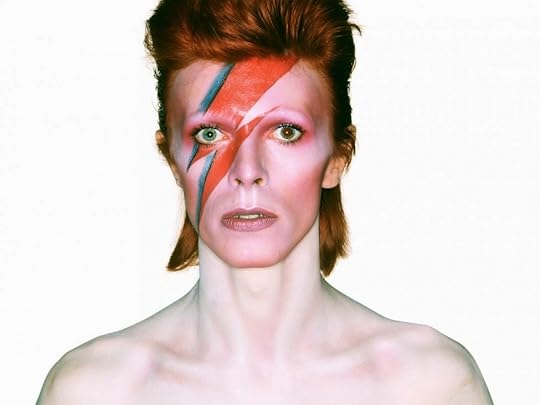 Like Bob Marley and reggae or Dylan and folk, David Bowie embodied the glam scene while simultaneously rising above it, creating his "Ziggy Stardust" persona after watching Bolan's career take off with a similar concept. Bowie had been a hippie folkie of sorts, particularly with 1969’s Space Oddity LP, but Marc's template appealed to both Bowie's theatrical side and his love for the simple, stripped-down rock 'n' roll also embodied by American friend, Lou Reed. The combination did for Bowie what it couldn't do for Bolan: it made him a star in the U.S. And while Bowie soon transmogrified into the Thin White duke, a blue-eyed soulster, a new wave experiment, even an EDM artist, it's his glam period people think of first when assessing his legacy. (See the Ziggy review in an earlier post.)
Like Bob Marley and reggae or Dylan and folk, David Bowie embodied the glam scene while simultaneously rising above it, creating his "Ziggy Stardust" persona after watching Bolan's career take off with a similar concept. Bowie had been a hippie folkie of sorts, particularly with 1969’s Space Oddity LP, but Marc's template appealed to both Bowie's theatrical side and his love for the simple, stripped-down rock 'n' roll also embodied by American friend, Lou Reed. The combination did for Bowie what it couldn't do for Bolan: it made him a star in the U.S. And while Bowie soon transmogrified into the Thin White duke, a blue-eyed soulster, a new wave experiment, even an EDM artist, it's his glam period people think of first when assessing his legacy. (See the Ziggy review in an earlier post.) This was the era that spawned The New York Dolls, Lou Reed’s Transformer, Slade, Sparks, The Sweet, Mott the Hoople and Roxy Music, the epitome of jaded androgynous style and European cool. One of the best, if not the very best, bands to come out of the 70s, Roxy Music were rock's last great innovators - on an epic scale; the sound they developed was the Lapis Lazuli to virtually every new musical genre originated since then. Their music can be roughly divided into two periods: the first two Brian Eno-dominated albums and everything else afterwards when the band's sound was dominated by Bryan Ferry's sultry croon. While the Eno albums do strike one as significantly different from the later stuff, one soon realizes that this difference has a purely technological character: the real heart of the band has always been Ferry.
This was the era that spawned The New York Dolls, Lou Reed’s Transformer, Slade, Sparks, The Sweet, Mott the Hoople and Roxy Music, the epitome of jaded androgynous style and European cool. One of the best, if not the very best, bands to come out of the 70s, Roxy Music were rock's last great innovators - on an epic scale; the sound they developed was the Lapis Lazuli to virtually every new musical genre originated since then. Their music can be roughly divided into two periods: the first two Brian Eno-dominated albums and everything else afterwards when the band's sound was dominated by Bryan Ferry's sultry croon. While the Eno albums do strike one as significantly different from the later stuff, one soon realizes that this difference has a purely technological character: the real heart of the band has always been Ferry.Though his contributions were colossal, Eno's departure, as he himself admitted, helped Roxy become a more focused, energized band. Eno helped Ferry morph his songs into referential collages and eerie synthscapes and that experimentation gave early Roxy their identity. Eno is easier to spot on Roxy's flashy, daring self-titled 1972 debut (the inventiveness of songs like "Ladytron" and "The Bob (Medley)" help to cover up rattly production values), but For Your Pleasure is a greater testament to Eno's importance. It's hard to imagine an album that better exploits the tensions between two fast-diverging creativities.
While T.Rex and Bowie created their music from out of the personas they'd become, Roxy Music created personas from out of the music. Though the end result was the same, the difference was evident and a key distinction in the evolution of glam.
Just a few AM classics from the Glam era:
David Bowie: Ziggy Stardust and the Spiders From Mars, Aladdin Sane, Diamond Dogs
Lou Reed: Transformer
Roxy Music: Stranded, For Your Pleasure, Country Life
T.Rex: The Slider
Eno: Here Come the Warm Jets



